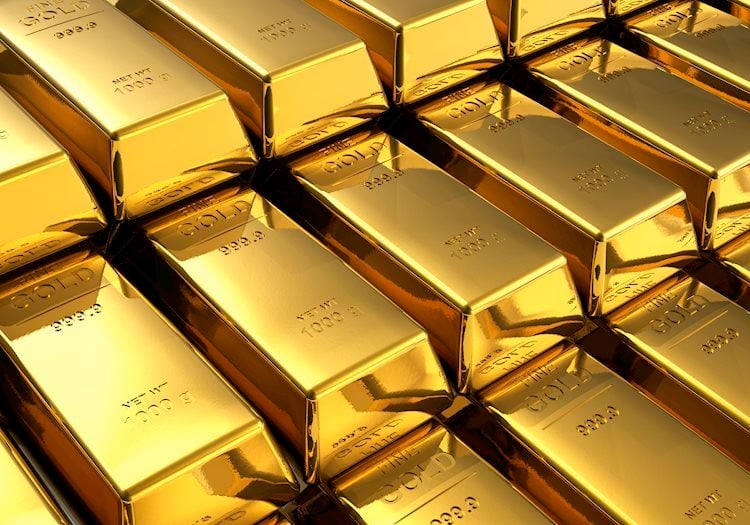Gold prices remained broadly unchanged in Pakistan on Wednesday, according to data compiled by FXStreet.
The price for Gold stood at 20,813.74 Pakistani Rupees (PKR) per gram, broadly stable compared with the PKR 20,824.20 it cost on Tuesday.
The price for Gold was broadly steady at PKR 242,768.50 per tola from PKR 242,889.40 per tola a day earlier.
| Unit measure | Gold Price in PKR |
|---|---|
| 1 Gram | 20,813.74 |
| 10 Grams | 208,137.50 |
| Tola | 242,768.50 |
| Troy Ounce | 647,380.30 |
FXStreet calculates Gold prices in Pakistan by adapting international prices (USD/PKR) to the local currency and measurement units. Prices are updated daily based on the market rates taken at the time of publication. Prices are just for reference and local rates could diverge slightly.
Global Market Movers: Gold price extends the range play as traders seek clarity about Fed rate-cut path
- Investors remain uncertain about the Federal Reserve’s rate-cut path, which, in turn, fails to provide any meaningful impetus to the Gold price and leads to subdued range-bound price action.
- The Fed last week lowered its projection for the number of rate cuts in 2024 to one from three in March, though the incoming US macro data keeps hopes alive for the first rate cut in September.
- The bets were lifted by softer US consumer and producer prices data released last week, which suggested that inflation is subsiding, and disappointing US Retail Sales figures on Tuesday.
- The Commerce Department reported that US Retail Sales rose 0.1% on a monthly basis in May as against the previous month’s downwardly revised fall of 0.2% and the 0.2% increase anticipated.
- The softer print pointed to signs of exhaustion among US consumers and that the economic activity was slowing, strengthening the case for the Fed to lower borrowing costs sooner than expected.
- In an interview with Fox Business, New York Fed President John Williams noted that the recent inflation data have been encouraging and added that he expects inflation to continue to come down.
- Richmond Fed President Thomas Barkin said that May inflation data was encouraging but it is hard to know how much signal to take from inflation last year, this quarter, or the last couple of weeks.
- Meanwhile, Boston Fed President Susan Collins said that inflation remains stubbornly high, and it will take more time than many had initially hoped to bring price growth back down to the 2% target.
- Fed Governor Adriana Kugler noted that economic conditions are moving in the right direction, and it is likely appropriate to begin easing policy sometime later this year if the economy evolves as expected.
- Dallas Fed President Lorie Logan reiterated that although tremendous progress has been made, inflation remains too high and will need to see ‘several more months’ to have confidence that it is heading to 2%.
- St. Louis Fed President Alberto Musalem noted that the labor market remains particularly tight and that it could take entire months or quarters before policies drag inflation back to the target levels.
- The US Dollar bulls remain on the defensive in the wake of the overnight decline in the US Treasury bond yields, lending some support to the non-yielding yellow metal amid absent relevant economic data.
(An automation tool was used in creating this post.)
Gold FAQs
Gold has played a key role in human’s history as it has been widely used as a store of value and medium of exchange. Currently, apart from its shine and usage for jewelry, the precious metal is widely seen as a safe-haven asset, meaning that it is considered a good investment during turbulent times. Gold is also widely seen as a hedge against inflation and against depreciating currencies as it doesn’t rely on any specific issuer or government.
Central banks are the biggest Gold holders. In their aim to support their currencies in turbulent times, central banks tend to diversify their reserves and buy Gold to improve the perceived strength of the economy and the currency. High Gold reserves can be a source of trust for a country’s solvency. Central banks added 1,136 tonnes of Gold worth around $70 billion to their reserves in 2022, according to data from the World Gold Council. This is the highest yearly purchase since records began. Central banks from emerging economies such as China, India and Turkey are quickly increasing their Gold reserves.
Gold has an inverse correlation with the US Dollar and US Treasuries, which are both major reserve and safe-haven assets. When the Dollar depreciates, Gold tends to rise, enabling investors and central banks to diversify their assets in turbulent times. Gold is also inversely correlated with risk assets. A rally in the stock market tends to weaken Gold price, while sell-offs in riskier markets tend to favor the precious metal.
The price can move due to a wide range of factors. Geopolitical instability or fears of a deep recession can quickly make Gold price escalate due to its safe-haven status. As a yield-less asset, Gold tends to rise with lower interest rates, while higher cost of money usually weighs down on the yellow metal. Still, most moves depend on how the US Dollar (USD) behaves as the asset is priced in dollars (XAU/USD). A strong Dollar tends to keep the price of Gold controlled, whereas a weaker Dollar is likely to push Gold prices up.
(An automation tool was used in creating this post.)
